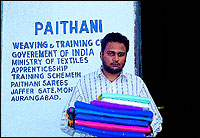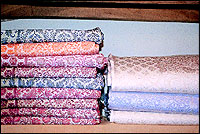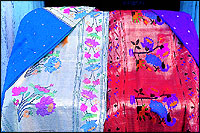


|
|
|
There are moments when I hold the Paithani
Paithani sarees have been a precious heirloom in India since the Shalivahan era of 2nd Century A.D. and have been passed down from mother to daughter for several generations. Traditional creative artistry and painstaking workmanship combine to form this unique cloth and make it an experience for the visual and tactile senses. It takes a master weaver an entire day to weave just an inch of this material and sometimes a saree is completed after a year-and-half! The Paithani sarees are expensive, they come for anything between Rs. 4,000 and Rs. 2.25 lakh. The price depends not on the material, but on the workmanship. He recommends a visit to the 150-year-old factory where the original treasure of Paithani and Himroo art is preserved. It is open between 7.30 a.m. and 10 p.m. every day. In the factory, you will see master craftsmen in action on double-sided looms painstakingly working on a saree or shawl. One will be a programmer who makes the design and the other, the weaver. Special designs are adopted from the frescoes of Ajanta or from traditional Mughal motifs of the time when Mohammed Tughlaq shifted his capital from Delhi to Daulatabad in the 14th Century A.D. People come from all over India to buy Paithani sarees at this factory. The factory also serves as a showroom for exquisite shawls, wall-hangings, cotton and silk bedspreads, decoration pieces, elaborate brocaded lengths of cloth, and Batik paintings that people take as souvenirs. Ajaz Qureshi says that it takes two people upto ten days to weave a two-metre Himroo shawl. The weavers skillfully combine silk with gold thread to produce some of the most opulent and sought after brocades in India. The shawls, depending on the material, cost between Rs. 800 and Rs. 25,000.
Aurangabad Himroo Art & Paithani Weaving & Training Centre, Jaffar Gate, Mondha Road,
Aurangabad 431 001.
|

Home Page
About the mag
Subscribe
Advertise
Contact Us

 Paithani Sarees, Himroo Shawls
Paithani Sarees, Himroo Shawls
 WELCOME to the fascinating world of Aurangabad�s Paithani sarees and Himroo shawls. Paithani sarees are known the world over among those with a discerning and refined taste, as a poem hand-woven in silk and gold. And of Himroo shawls, the great adventurer Marco Polo once wrote of the fabric that was given to him in the Deccan region, �It is as fine as a spider�s web and Kings and Queens of any country will take pride in wearing it!�
WELCOME to the fascinating world of Aurangabad�s Paithani sarees and Himroo shawls. Paithani sarees are known the world over among those with a discerning and refined taste, as a poem hand-woven in silk and gold. And of Himroo shawls, the great adventurer Marco Polo once wrote of the fabric that was given to him in the Deccan region, �It is as fine as a spider�s web and Kings and Queens of any country will take pride in wearing it!� The art of weaving the Paithani almost died down but for the efforts of a Qureshi family from Aurangabad to revive it over a 100 years ago during the time of the Nizam of Hyderabad. The Qureshis preserved and promoted the art and the 13th generation of that famous family, Ajaz Ahmed Qureshi, today runs the Aurangabad Himroo Industry and the Paithani Weaving and Training Centre at Jaffer Gate, Mondha Road, in Aurangabad. Both are Government of India undertakings. The government sponsors the looms for the work and runs training schemes for people interested in the art of weaving. Ajaz Qureshi, who learnt the job from his father, is a master craftsman himself and specialises in weaving and designing.
The art of weaving the Paithani almost died down but for the efforts of a Qureshi family from Aurangabad to revive it over a 100 years ago during the time of the Nizam of Hyderabad. The Qureshis preserved and promoted the art and the 13th generation of that famous family, Ajaz Ahmed Qureshi, today runs the Aurangabad Himroo Industry and the Paithani Weaving and Training Centre at Jaffer Gate, Mondha Road, in Aurangabad. Both are Government of India undertakings. The government sponsors the looms for the work and runs training schemes for people interested in the art of weaving. Ajaz Qureshi, who learnt the job from his father, is a master craftsman himself and specialises in weaving and designing.